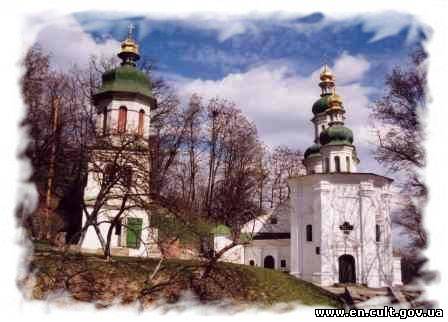 On the west of the Boldyn Hill above the boundless Desna high-water bed among Slavic burial mounds the huge ensemble of St. Trinity – St. Elijah monastery rises.
On the west of the Boldyn Hill above the boundless Desna high-water bed among Slavic burial mounds the huge ensemble of St. Trinity – St. Elijah monastery rises. At the bottom of the hill there is a small St. Elijah church which is the oldest memorial of this monastery ensemble.First it was a place for christening. It was a small domical church which consisted of rectangular women part, nave and semicircular apse.
The smallish vestibule abutted upon the west side of the women part. Annals don’t recollect the time of church construction, so there is no single viewpoint among the researchers about the time of its building up.
The criterion to date the monument is the study of its architecture, building technology, material. The majority of researches relate St. Elijah church to the end of the XII century.The modern view of St. Elijah church is the result of the XVII – XVIII century reconstructions. During the Mongol-Tatar invasion (1239) the church was destroyed. At the end of the XVI century the walls were adorned with the cornice. Small domes were built above the apse and the women part and the church turned into three-dome.
The vestry was attached to the south side of the apse. The monument survived fundamental reconstructions in the middle of the XVII century: instead of disassembled vestibule a big faceted room was built to make the church area bigger. A multi-tier top was built above the central dome. The dome above the old women part was disassemble and a new one was built above the annex. As a result of these reconstructions the monument got features of Ukrainian baroque style. Outside and inside the church was plastered and whitewashed.
A predominant feature of the interior is high-altitude principle of opening the internal space. The main feature is using the elements of Byzantine crusiform system along with pillarless temple composition which is typical for wooden architecture. An ancient décor was lost. Neither fresco nor glazed ceramic dalle remained.
Only iconostasis (1774) in rococo style with interpreted Corinthian order remained. St. Elijah church was restored according to M.M. Hovdenko’s project in 1970s. Nowadays St. Elijah church is the only building of such type of Kyiv Russ architecture which completely remained. It initiated the development of three-fraction church type in Ukrainian brickwork architecture of the ХІІІ – ХVІІІ centuries.
In 1908-1910 a three-tier bell-tower like “octahedron on tchetverik” was built to the north-west of St. Elijah church. The lower two-tier tchetverik is made of bricks, the upper – octahedron – is wooden. A two-tier baroque style dome crowns the tower.
Since 1967 St. Elijah church has affiliated National architectural-historic Park “Ancient Chernihiv”and now is one of its museums.


























